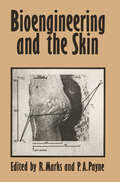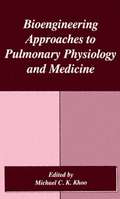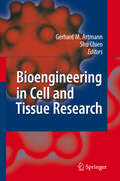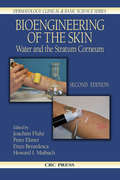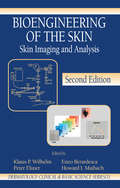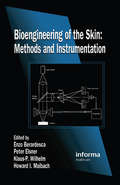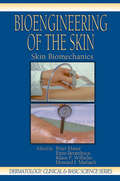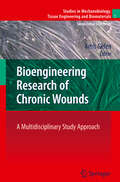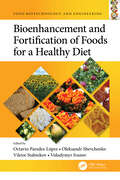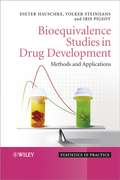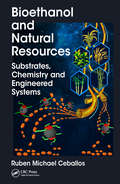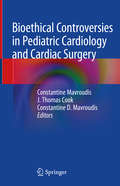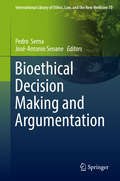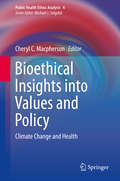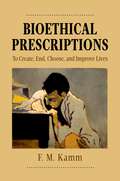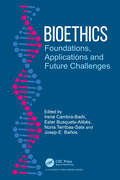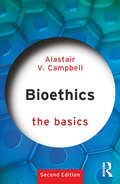- Table View
- List View
Bioengineering and the Skin: Based on the Proceedings of the European Society for Dermatological Research Symposium, held at the Welsh National School of Medicine, Cardiff, 19–21 July 1979
by R. MarksR. MARKS Biology has become a 'numbers game'. The advantages of being able to grade changes in tissue, submit results to statistical analysis and accurately record biological phenomena make measurement essential. This is as true for the various disciplines in applied biology as it is for the more esoteric aspects ofthe subject. Regrettably, sk in biologists until recently had not seized the opportunities that the availability of their tissue of interest afforded and fell behind in the exploration of measurement techniques. Probably this resulted in part from the mistaken sentiment that 'to see is to know'. It also originated from the complexity ofthe skin which. as a closely interwoven mixture oftissue types. makes assessments technically difficult. However, we are optimistic about the future. The International Society for Bioengineering and the Skin was formed in Cardiff in ] uly 1979 in response to the wishes of the delegates who had attended the first International Symposium on the subject in Miami in 1976 and the second in Cardiff 3 years later. This volume is the proceedings of the Cardiff meeting. We believe that it demonstrates the brave efforts and variety of new ideas that characterise the studies of scientists who realise the importance of blending the phYSICal sciences with skin biology.
Bioengineering Approaches to Pulmonary Physiology and Medicine
by Michael C. K. KhooAs the current millennium steams towards a close, one cannot help but look with amazement at the incredible amount of progress that has been achieved in medicine in just the last few decades. A key contributing factor to this success has been the importation and blending of ideas and techniques from disciplines outside the traditional borders of medical science. In recent years, the most well-known example is the cross-pollination between molecular biology and medicine. Advances driven by this potent combination have spawned the vision of a future where cures based on gene therapy become commonplace. Yet, as we continue our search for "magic bullets" in the quest to eradicate disease, it important to recognize the value of other less-heralded interdisciplinary efforts that have laid a large part of the foundation of present-day medicine. In pulmonary medicine, the contribution from the bioengineers (a diverse collection of individuals cross-bred to various degrees in mathematical modeling and experimental physiology) has been larger and more sustained than in many other medical specialties. It is easy to point to the vast array of ventilators, blood-gas analyzers, oximeters, pulmonary function devices, and respiration monitors that are present in any modern clinical setting as solid evidence of the successful synergy between engineering science and pulmonary medicine. However, one must not forget the less tangible, but perhaps more important, contributions that have been derived from mathematical modeling and computer simulation, without which many of these modern instruments would not have come into existence.
Bioengineering in Cell and Tissue Research
by Gerhard M. Artmann Shu ChienCutting edge research in cell and tissue research abounds in this review of the latest technological developments in the area. The chapters are written by excellent scientists on advanced, frontier technology and address scientific questions that require considerable engineering brainpower. The aim is to provide students and scientists working in academia and industry new information on bioengineering in cell and tissue research to enhance their understanding and innovation.
Bioengineering of the Skin: Water and the Stratum Corneum, 2nd Edition
by Enzo Berardesca Peter Elsner Howard I. Maibach Joachim W. FluhrBioengineering of the skin, or more precisely the biophysical assessment of skin physiology, is moving rapidly from a descriptive approach to a deeper understanding of biophysical and biochemical processes. This second edition of the popular text Bioengineering of the Skin: Water and Stratum Corneum reflects the progress in the field, focusing on t
Bioengineering of the Skin: Skin Imaging & Analysis
by Enzo Berardesca Peter Elsner Howard I. Maibach Klaus-Peter WilhelmSpanning the many advancements that have taken place in the field since the First Edition of this book was published, this Second Edition emphasizes the imaging of the skin in its entirety, rather than focusing solely on surface layers. The Second Edition includes new chapters on technologies such as in vivo confocal laser scanning microscopy, Rama
Bioengineering of the Skin: Methods and Instrumentation, Volume III (Dermatology: Clinical And Basic Science Ser. #9)
by Enzo Berardesca Peter Elsner Klaus-P. Wilhelm Howard I. MaibachSkin bioengineering is an expanding field of investigative and clinical dermatology. This guide describes all commercially available techniques and instruments. It provides a thorough overview of methods for noninvasive investigation of skin function. Commercially available instruments are reviewed and compared, with updated references given for each instrument. This book offers a technical analysis of each instrument, allowing investigators to understand its biophysical principles and to make better purchases of lab instruments. Addresses of manufacturers and worldwide distributors are included, making this an essential reference source.Chapters are written by international experts. Topics include transepidermal water loss, hydration, the measurement of skin blood flow in Laser-Doppler flowetry, sebum, pH and ions, and transcutaneous pO2 and pO2 measurements. Skin color, roughness, and elasticity are examined in detail. Skin imaging techniques, capillaroscopy, and fluorescence videomicroscopy are described. Instruments for surface microscopy of the skin are also discussed.Bioengineering of the Skin explains state-of-the-art techniques and is valuable reading for anyone who needs to stay abreast of the latest activities in this ever-changing field.
Bioengineering of the Skin: Methods and Instrumentation, Volume III
by Enzo Berardesca Peter Elsner Klaus-Peter Wilhelm Howard I. MaibachSkin bioengineering is an expanding field of investigative and clinical dermatology. This guide describes all commercially available techniques and instruments. It provides a thorough overview of methods for noninvasive investigation of skin function. Commercially available instruments are reviewed and compared, with updated references given for each instrument. This book offers a technical analysis of each instrument, allowing investigators to understand its biophysical principles and to make better purchases of lab instruments. Addresses of manufacturers and worldwide distributors are included, making this an essential reference source.Chapters are written by international experts. Topics include transepidermal water loss, hydration, the measurement of skin blood flow in Laser-Doppler flowetry, sebum, pH and ions, and transcutaneous pO2 and pO2 measurements. Skin color, roughness, and elasticity are examined in detail. Skin imaging techniques, capillaroscopy, and fluorescence videomicroscopy are described. Instruments for surface microscopy of the skin are also discussed.Bioengineering of the Skin explains state-of-the-art techniques and is valuable reading for anyone who needs to stay abreast of the latest activities in this ever-changing field.
Bioengineering of the Skin: Skin Biomechanics, Volume V
by Peter Elsner Enzo Berardesca Klaus-Peter WilhelmSince skin forms the interface between the human body and the environment, its mechanical properties are important in health and disease. Bioengineering of the Skin: Skin Biomechanics gives a thorough introduction in the biological basis of skin biomechanics. It explains the non-invasive methods that allow measurement of the mechanical properties o
Bioengineering Research of Chronic Wounds: A Multidisciplinary Study Approach (Studies in Mechanobiology, Tissue Engineering and Biomaterials #1)
by Amit GefenPressure-related chronic wounds are an important health concern that affects millions of patients and accumulates billions in annual costs. These wounds may occur when soft tissues are mechanically compressed between bony prominences and a supporting surface. This book gives a complete and quantitative explanation of the mechanobiology which causes chronic wounds. The reviews give an overall picture on all length scales of the phenomenon, starting from musculoskeletal biomechanics to the modeling of soft tissues and their interaction with bones. At the microscopic levels, it thoroughly reviews experiments and modeling of cellular forces and molecular processes that occur during injury and healing, including the integrity of living cells subjected to sustained mechanical forces and deformations. The results allow a complete picture of the tolerance of human tissues to sustained loads, and an understanding of the risk for onset of chronic wounds. Hence, this book is also valuable for all professionals involved in the prevention and treatment of chronic wounds.
Bioenhancement and Fortification of Foods for a Healthy Diet (Food Biotechnology and Engineering)
by Octavio Paredes-López Oleksandr Shevchenko Viktor Stabnikov Volodymyr IvanovBioenhancements of cereal and dairy compositions can play an important role in healthy diets. The latest addition to the new Food Biotechnology and Engineering series, Bioenhancement and Fortification of Foods for a Healthy Diet covers the technological and nutritional aspects of the compositions of cereals, dairy products, vegetables, and fruits. The book demonstrates real developments in food technology and reviews current knowledge in the biotechnological processing and bioenhancement of food. Key Features: Promotes the use of iron-containing nanoadditive in bakery and confectionary Explains the use of food additives for enrichment of butter mixtures Covers the use of artichoke powder and buckwheat bran in diabetic bakery products Describes the use of milk proteins in the technology of bakery products Proposes the use of spice compositions for sour milk products Organized in five parts, Bioenhancement and Fortification of Foods for a Healthy Diet addresses bakery and confectionery products, technologies for cereals enhancement, technologies for dairy products enhancement, food supplements, and finally, new technology processes. The book is an aide to food scientists and engineers contributing to the development of high-quality food products. Also available in the Food Biotechnology and Engineering series: Volatile Compounds Formation in Specialty Beverages, edited by Felipe Richter Reis and Caroline Mongruel Eleutério dos Santos (ISBN: 9780367631901) Native Crops in Latin America: Biochemical, Processing, and Nutraceutical Aspects, edited by Ritva Repo-Carrasco-Valencia and Mabel C. Tomás (ISBN: 9780367531409) For a complete list of books in this series, please visit our website at: https://www.routledge.com/Food-Biotechnology-and-Engineering/book-series/CRCFOOBIOENG
Bioenhancement and Fortification of Foods for a Healthy Diet (Food Biotechnology and Engineering)
by Octavio Paredes-López Oleksandr Shevchenko Viktor Stabnikov Volodymyr IvanovBioenhancements of cereal and dairy compositions can play an important role in healthy diets. The latest addition to the new Food Biotechnology and Engineering series, Bioenhancement and Fortification of Foods for a Healthy Diet covers the technological and nutritional aspects of the compositions of cereals, dairy products, vegetables, and fruits. The book demonstrates real developments in food technology and reviews current knowledge in the biotechnological processing and bioenhancement of food. Key Features: Promotes the use of iron-containing nanoadditive in bakery and confectionary Explains the use of food additives for enrichment of butter mixtures Covers the use of artichoke powder and buckwheat bran in diabetic bakery products Describes the use of milk proteins in the technology of bakery products Proposes the use of spice compositions for sour milk products Organized in five parts, Bioenhancement and Fortification of Foods for a Healthy Diet addresses bakery and confectionery products, technologies for cereals enhancement, technologies for dairy products enhancement, food supplements, and finally, new technology processes. The book is an aide to food scientists and engineers contributing to the development of high-quality food products. Also available in the Food Biotechnology and Engineering series: Volatile Compounds Formation in Specialty Beverages, edited by Felipe Richter Reis and Caroline Mongruel Eleutério dos Santos (ISBN: 9780367631901) Native Crops in Latin America: Biochemical, Processing, and Nutraceutical Aspects, edited by Ritva Repo-Carrasco-Valencia and Mabel C. Tomás (ISBN: 9780367531409) For a complete list of books in this series, please visit our website at: https://www.routledge.com/Food-Biotechnology-and-Engineering/book-series/CRCFOOBIOENG
Bioequivalence and Statistics in Clinical Pharmacology (Chapman & Hall/CRC Biostatistics Series)
by Scott D. Patterson Byron JonesMaintaining a practical perspective, Bioequivalence and Statistics in Clinical Pharmacology, Second Edition explores statistics used in day-to-day clinical pharmacology work. The book is a starting point for those involved in such research and covers the methods needed to design, analyze, and interpret bioequivalence trials; explores when, how, and why these studies are performed as part of drug development; and demonstrates the methods using real world examples. Drawing on knowledge gained directly from working in the pharmaceutical industry, the authors set the stage by describing the general role of statistics. Once the foundation of clinical pharmacology drug development, regulatory applications, and the design and analysis of bioequivalence trials are established, including recent regulatory changes in design and analysis and in particular sample-size adaptation, they move on to related topics in clinical pharmacology involving the use of cross-over designs. These include, but are not limited to, safety studies in Phase I, dose-response trials, drug interaction trials, food-effect and combination trials, QTc and other pharmacodynamic equivalence trials, proof-of-concept trials, dose-proportionality trials, and vaccines trials. This second edition addresses several recent developments in the field, including new chapters on adaptive bioequivalence studies, scaled average bioequivalence testing, and vaccine trials. Purposefully designed to be instantly applicable, Bioequivalence and Statistics in Clinical Pharmacology, Second Edition provides examples of SAS and R code so that the analyses described can be immediately implemented. The authors have made extensive use of the proc mixed procedures available in SAS.
Bioequivalence and Statistics in Clinical Pharmacology (Chapman & Hall/CRC Biostatistics Series)
by Scott D. Patterson Byron JonesMaintaining a practical perspective, Bioequivalence and Statistics in Clinical Pharmacology, Second Edition explores statistics used in day-to-day clinical pharmacology work. The book is a starting point for those involved in such research and covers the methods needed to design, analyze, and interpret bioequivalence trials; explores when, how, and why these studies are performed as part of drug development; and demonstrates the methods using real world examples. Drawing on knowledge gained directly from working in the pharmaceutical industry, the authors set the stage by describing the general role of statistics. Once the foundation of clinical pharmacology drug development, regulatory applications, and the design and analysis of bioequivalence trials are established, including recent regulatory changes in design and analysis and in particular sample-size adaptation, they move on to related topics in clinical pharmacology involving the use of cross-over designs. These include, but are not limited to, safety studies in Phase I, dose-response trials, drug interaction trials, food-effect and combination trials, QTc and other pharmacodynamic equivalence trials, proof-of-concept trials, dose-proportionality trials, and vaccines trials. This second edition addresses several recent developments in the field, including new chapters on adaptive bioequivalence studies, scaled average bioequivalence testing, and vaccine trials. Purposefully designed to be instantly applicable, Bioequivalence and Statistics in Clinical Pharmacology, Second Edition provides examples of SAS and R code so that the analyses described can be immediately implemented. The authors have made extensive use of the proc mixed procedures available in SAS.
Bioequivalence Requirements in Various Global Jurisdictions (AAPS Advances in the Pharmaceutical Sciences Series #28)
by Isadore KanferAlthough the Bioequivalence (BE) requirements in many global jurisdictions have much in common, differences in certain approaches and requirements such as definitions and terms, choice of comparator (reference) product, acceptance criteria, fasted and fed studies, single and multi-dose studies, biowaivers and products not intended for absorption into the systemic circulation (locally acting medicines and dosage forms), amongst others, provide food for thought that standardisation should be a high priority objective in order to result in a harmonized international process for the market approval of products using BE. An important objective of Bioequivalence Requirements in Various Global Jurisdictions is to attempt to gather the various BE requirements used in different global jurisdictions to provide a single source of relevant information. This information from, Brazil, Canada, China, European Union, India, Japan, MENA, Russia South Africa, the USA and WHO will be of value to drug manufacturers, regulatory agencies, pharmaceutical scientists and related health organizations and governments around the world in the quest to harmonize regulatory requirements for the market approval of generic products.
Bioequivalence Studies in Drug Development: Methods and Applications (Statistics in Practice #60)
by Dieter Hauschke Volker Steinijans Iris PigeotStudies in bioequivalence are the commonly accepted method to demonstrate therapeutic equivalence between two medicinal products. Savings in time and cost are substantial when using bioequivalence as an established surrogate marker of therapeutic equivalence. For this reason the design, performance and evaluation of bioequivalence studies have received major attention from academia, the pharmaceutical industry and health authorities. Bioequivalence Studies in Drug Development focuses on the planning, conducting, analysing and reporting of bioequivalence studies, covering all aspects required by regulatory authorities. This text presents the required statistical methods, and with an outstanding practical emphasis, demonstrates their applications through numerous examples using real data from drug development. Includes all the necessary pharmacokinetic background information. Presents parametric and nonparametric statistical techniques. Describes adequate methods for power and sample size determination. Includes appropriate presentation of results from bioequivalence studies. Provides a practical overview of the design and analysis of bioequivalence studies. Presents the recent developments in methodology, including population and individual bioequivalence. Reviews the regulatory guidelines for such studies, and the existing global discrepancies. Discusses the designs and analyses of drug-drug and food-drug interaction studies. Bioequivalence Studies in Drug Development is written in an accessible style that makes it ideal for pharmaceutical scientists, clinical pharmacologists, and medical practitioners, as well as biometricians working in the pharmaceutical industry. It will also be of great value for professionals from regulatory bodies assessing bioequivalence studies.
Bioethanol and Natural Resources: Substrates, Chemistry and Engineered Systems
by Ruben Michael CeballosBioethanol and Natural Resources: Substrates, Chemistry and Engineered Systems provides a comprehensive review of feedstocks, physiochemical and biological pretreatments, molecular substrates, cellulolytic and ligninolytic enzymes, and advanced technologies for producing bioethanol. Although this book provides a review of first-generation bioethanol feedstocks, chemistry, and processes, there is an emphasis on second-generation "cellulosic" ethanol production. With rapid advances in biofuels technologies and the continued global dependency on unsustainable extraction of fossil fuels, this text is timely. Although it is intended to be used as a supplemental text for advanced undergraduate or graduate level courses, the book is accessible to a non-academic audience. This book provides a unique opportunity to understand bioethanol production from the basic concepts and processes to the most cutting-edge technologies under development.
Bioethanol and Natural Resources: Substrates, Chemistry and Engineered Systems
by Ruben Michael CeballosBioethanol and Natural Resources: Substrates, Chemistry and Engineered Systems provides a comprehensive review of feedstocks, physiochemical and biological pretreatments, molecular substrates, cellulolytic and ligninolytic enzymes, and advanced technologies for producing bioethanol. Although this book provides a review of first-generation bioethanol feedstocks, chemistry, and processes, there is an emphasis on second-generation "cellulosic" ethanol production. With rapid advances in biofuels technologies and the continued global dependency on unsustainable extraction of fossil fuels, this text is timely. Although it is intended to be used as a supplemental text for advanced undergraduate or graduate level courses, the book is accessible to a non-academic audience. This book provides a unique opportunity to understand bioethanol production from the basic concepts and processes to the most cutting-edge technologies under development.
Bioethical Controversies in Pediatric Cardiology and Cardiac Surgery
by Constantine Mavroudis J. Thomas Cook Constantine D. MavroudisThis title reviews the bioethical issues in congenital heart disease and other difficult pediatric cardiology and cardiac surgical situations. It provides considered opinions and recommendations as to the preferred actions to take in these cases, stressing the importance of making informed decisions that are bioethically sound and doing so using considered reasoning of all the related sensitive issues.Bioethical Controversies in Pediatric Cardiology and Cardiac Surgery provides detailed recommendations on potential solutions to make bioethical decisions in difficult clinical scenarios. There is particular emphasis on controversies involving surgery for hypoplastic left heart syndrome, futility, informed consent, autonomy, genomics, and beneficence. It is intended for use by a wide range of practitioners, including congenital heart surgeons, pediatric cardiologists, pediatric intensivists, nurse practitioners, physician’s assistants, and clinical ethicists.
Bioethical Decision Making and Argumentation (International Library of Ethics, Law, and the New Medicine #70)
by Pedro Serna José-Antonio SeoaneThis book clarifies the meaning of the most important and pervasive concepts and tools in bioethical argumentation (principles, values, dignity, rights, duties, deliberation, prudence) and assesses the methodological suitability of the main methods for clinical decision-making and argumentation. The first part of the book is devoted to the most developed or promising approaches regarding bioethical argumentation, namely those based on principles, values and human rights. The authors then continue to deal with the contributions and shortcomings of these approaches and suggest further developments by means of substantive and procedural elements and concepts from practical philosophy, normative systems theory, theory of action, human rights and legal argumentation. Furthermore, new models of biomedical and health care decision-making, which overcome the aforementioned criticism and stress the relevance of the argumentative responsibility, are included.
Bioethical Insights into Values and Policy: Climate Change and Health (Public Health Ethics Analysis #4)
by Cheryl C. MacphersonChanges in earth’s atmosphere, oceans, soil, weather patterns, and ecosystems are well documented by countless scientific disciplines. These manifestations of climate change harm public health. Given their goals and social responsibilities, influential health organizations recognize health impacts compounded by geography, social values, social determinants of health, health behaviors, and relationships between humans and environments primarily described in feminist ethics and environmental ethics. Health impacts are relevant to, but seldom addressed in bioethics, global health, public policy, or health or environmental policy. This book is the first to describe cultural, geographic, and socioeconomic factors that influence the regional significance of these impacts and frame them for bioethics and policy analyses.
Bioethical Prescriptions: To Create, End, Choose, and Improve Lives (Oxford Ethics Series)
by F.M. KammBioethical Prescriptions collects F.M. Kamm's articles on bioethics, which have appeared over the last twenty-five years and which have made her among the most influential philosophers in this area. Kamm is known for her intricate, sophisticated, and painstaking philosophical analyses of moral problems generally and of bioethical issues in particular. This volume showcases these articles -- revised to eliminate redundancies -- as parts of a coherent whole. A substantive introduction identifies important themes than run through the articles. Section headings include Death and Dying; Early Life (on conception and use of embryos, abortion, and childhood); Genetics and Other Enhancements (on cloning and other genetic technologies); Allocating Scarce Resources; and Methodology (on the relation of moral theory and practical ethics).
Bioethics: Passing the Boards, Providing Patient Care, and Beyond
by PhD Jeffrey W. BulgerDelve into the intriguing world of medical ethics in this unique guidebook, where each ethical dilemma is introduced through a gripping moral mystery story. Bioethics: Passing the Boards, Providing Patient Care, and Beyond explores the complex ethical challenges faced by today's healthcare professionals, guiding readers in striking the delicate balance between societal expectations, professional codes of conduct, and patients' goals, values, and priorities. This innovative resource presents sixty topics designed to educate and captivate medical and healthcare students and practitioners. Each issue focuses on high-yield content crucial for medical licensing exams for all medical practitioners. The book is an essential reference for clinical practice, ethics consultations, and academic writings. While the ethical issues discussed may spark varied opinions rooted in personal, religious, or political beliefs, the book draws from moral positions issued by various medical professional organizations, offering a framework for behavioral expectations within the medical community. By immersing themselves in the moral mystery stories, the ethical analysis, and applying the acquired knowledge to review questions and the NBME-style clinical vignettes, healthcare professionals will gain the necessary tools and skills to adhere to ethical and legal standards of care in their practice. Engage in this thought-provoking exploration of medical ethics and emerge well-equipped to navigate the challenges of making life-altering decisions.
Bioethics: Passing the Boards, Providing Patient Care, and Beyond
by PhD Jeffrey W. BulgerDelve into the intriguing world of medical ethics in this unique guidebook, where each ethical dilemma is introduced through a gripping moral mystery story. Bioethics: Passing the Boards, Providing Patient Care, and Beyond explores the complex ethical challenges faced by today's healthcare professionals, guiding readers in striking the delicate balance between societal expectations, professional codes of conduct, and patients' goals, values, and priorities. This innovative resource presents sixty topics designed to educate and captivate medical and healthcare students and practitioners. Each issue focuses on high-yield content crucial for medical licensing exams for all medical practitioners. The book is an essential reference for clinical practice, ethics consultations, and academic writings. While the ethical issues discussed may spark varied opinions rooted in personal, religious, or political beliefs, the book draws from moral positions issued by various medical professional organizations, offering a framework for behavioral expectations within the medical community. By immersing themselves in the moral mystery stories, the ethical analysis, and applying the acquired knowledge to review questions and the NBME-style clinical vignettes, healthcare professionals will gain the necessary tools and skills to adhere to ethical and legal standards of care in their practice. Engage in this thought-provoking exploration of medical ethics and emerge well-equipped to navigate the challenges of making life-altering decisions.
Bioethics: Foundations, Applications and Future Challenges
by Irene Cambra-Badii Ester Busquets-Alibés Terribas-Sala Núria Josep-E. BañosThe aim of this book is to introduce and discuss bioethics in a three-synergistic way: from the foundations to the current debates in relation to healthcare and social bioethics, and thereafter the possible future challenges. In this sense, the target audience can be from diverse disciplines: life and medical sciences, law, philosophy, psychology, and education. The book will be useful to high school students, in their first contacts with bioethics, college students, teachers and researchers, and the general public interested in these controversial debates of the past, present and future of bioethics.
Bioethics: The Basics (The Basics)
by Alastair V. CampbellBioethics: The Basics is an introduction to the foundational principles, theories and issues in the study of medical and biological ethics. Readers are introduced to bioethics from the ground up before being invited to consider some of the most controversial but important questions facing us today. Topics addressed include: the range of moral theories underpinning bioethics arguments for the rights and wrongs of abortion, euthanasia and animal research health care ethics including the nature of the practitioner-patient relationship public policy ethics and the implications of global and public health ‘3 parents’, enhancement, incidental findings and nudge approaches in health care. This thoroughly revised second edition provides a concise, readable and authoritative introduction for anyone interested in the study of bioethics.
